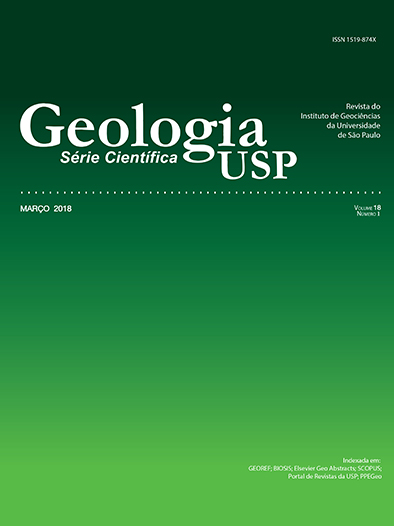Fluid inclusions study on quartz from a magmatic-hydrothermal system in the Papagaio Artisanal Mining District, Alta Floresta Gold Province, Mato Grosso state, Amazon Craton
DOI:
https://doi.org/10.11606/issn.2316-9095.v18-136701Keywords:
Amazon Craton, Alta Floresta Gold Province, Fluid inclusions, Microthermometry, Magmatic fluids.Abstract
The Papagaio artisanal gold mining in Paranaíta, Mato Grosso, Brazil, is located in the northwest sector of Alta Floresta Gold Province, in the southern Amazon Craton. Mineralization is hosted in porphyritic dacite initially affected by a potassic alteration that is superimposed by a strong pervasive sericitic alteration and, finally, by propylitic alteration. The ore paragenesis consists of pyrite + chalcopyrite + sphalerite ± galena ± chalcocite ± covellite that is located in a quartz veins systems and stockworks that cuts hydrothermal potassic and sericitic alteration zones. Studies of fluid inclusions of the mineralized and barren veins present in the mining identified three groups of fluid inclusions: type I) aqueous-carbonic inclusions; type II) aqueous biphasic inclusions; type III) aqueous tri- to multiphase inclusions. In the mineralized veins, the type I inclusions decrepitated at 325ºC. Type II inclusions have homogenization temperatures of 115.1 to 216.2ºC and salinities of 0.5 to 24.0%. In the barren veins, type II inclusions yielded total homogenization temperatures between 135.9 and 190.3ºC and salinities of 26.0 to 30.2%. In type III inclusions, the total homogenization was between 323.2 and 402.9ºC with salinity greater than 40.0%. Therefore, high-temperature and high-salinity fluids with characteristics of magmatic origin had essential role in the formation of the mineralized zones of the artisanal mining. In this context, the placement of subvolcanic bodies would have been indispensable for the genesis of the gold mineralization at Papagaio. These subvolcanic bodies would have served as a source of heat, fluid, and metals for the development of a deep magmatic-hydrothermal system, possibly associated with the environment of the porphyry and intrusion-related gold systems (IRGS).
Downloads
Downloads
Published
Issue
Section
License
Authors who publish in this journal shall comply with the following terms:
- Authors keep their copyright and grant to Geologia USP: Série Científica the right of first publication, with the paper under the Creative Commons BY-NC-SA license (summary of the license: https://creativecommons.org/licenses/by-nc-sa/4.0 | full text of the license: https://creativecommons.org/licenses/by-nc-sa/4.0/legalcode) that allows the non-commercial sharing of the paper and granting the proper copyrights of the first publication in this journal.
- Authors are authorized to take additional contracts separately, for non-exclusive distribution of the version of the paper published in this journal (publish in institutional repository or as a book chapter), granting the proper copyrights of first publication in this journal.
- Authors are allowed and encouraged to publish and distribute their paper online (in institutional repositories or their personal page) at any point before or during the editorial process, since this can generate productive changes as well as increase the impact and citation of the published paper (See The effect of Open Access and downloads on citation impact).





